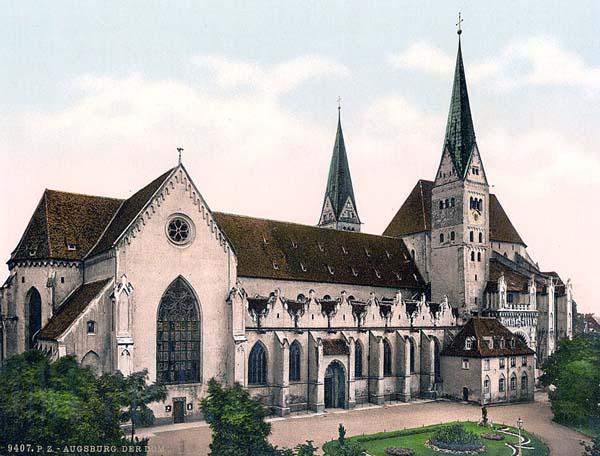Augsburg Cathedral
|
Augsburg Cathedral is an 11th-century Romanesque cathedral with 14th-century Gothic additions in Bavaria, Germany. It contains many notable artworks, including the oldest stained glass windows in the country. It is possible a church has stood here since the 4th century: foundations from this date have been found beneath the cathedral, but it is not clear the building was a church. The first known cathedral on this site was built in the late 8th century and the first written mention of it is in 822. The cathedral was damaged during the Hungarian invasions and restored under Bishop Ulrich in 923. The west end collapsed in 994 and was rebuilt with the help of Empress Adelaide, who claimed to have foreseen the destruction in a vision. Continued below. |

|
|
Augsburg Cathedral Construction on the present Romanesque cathedral began under Bishop Henry IIin 1043 and was completed under his successor in 1065. This building still forms the core of the cathedral, although much of it was given a Gothic makeover from 1331 to 1431. The east choir is a fully Gothic addition of 1356-1431. Iconoclasts seized and destroyed most of the cathedral's religious art during the Protestant Reformation (1537-48), some of which was restored later. The north tower was heightened in 1565. The interior was given the Baroque treatment in 1655-58, then reversed in in 1852-63 to restore it to a romanticized vision of its medieval appearance. More medieval artworks were brought in to complete the effect. The Neo-Gothic elements were removed in 1934. Augsburg Cathedral was fairly lucky in World War II; only the Lady Chapel and cloister were damaged. Extensive restorations of the interior were undertaken in 1983-84. Photo 21, 1985 |

|
|
Augsburg Cathedral Photo 22, 1985 |

|
|
Augsburg Cathedral Photo 23, 1985 |

|